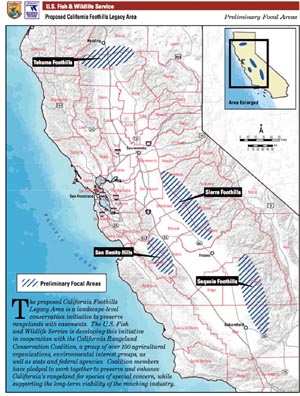
With less than two weeks before representatives from the U.S.
Fish and Wildlife Service present a case for the establishment of a
3.4 million
–acre statewide conservation project – including nearly 500,000
acres in San Benito County – local residents are awaiting further
details on how the proposal could affect the region.
With less than two weeks before representatives from the U.S. Fish and Wildlife Service present a case for the establishment of a 3.4 million–acre statewide conservation project – including nearly 500,000 acres in San Benito County – local residents are awaiting further details on how the proposal could affect the region.
The proposal with potential impacts on much of the Central Valley could multiply the California acreage in easements with the fish and wildlife service by eight times, or even more. The recently publicized idea includes an 18 million–acre “study area” and then four “focal areas” within that.
There are 489,479 acres included in San Benito County included in one of the focal areas, the “San Benito Hills.” Being so early in the process, it is unknown what the voluntary–easement plan means for landowners – or current projects – in the area.
“Honestly, I just don’t know,” said San Benito County Farm Bureau Treasurer Greg Swett, a South County orchardist. “I have no understanding of the project or what they are planning on doing.”
The plan estimates landowners will receive around $1,000 per acre. The actual value will fluctuate depending on the appraised value.
The easement plan has an initial goal of setting aside 900,000 acres in California.
Swett admitted he didn’t know much about the project, but he expressed concern it could turn the county into a large “state park” depending on the easement restrictions.
“I don’t know much about the project, but as with every easement plan, it depends on the short- and long-term effect,” he said. “That’s what people should be worried about.”
Rancher Joe Morris from the San Juan area believes the success of the proposal depends on the details in the easement plan and what types of restrictions would be placed on the lands.
“The devil is in the details,” Morris said. “It’s a voluntary thing, and that’s obviously something I would be in favor of. But I will have to wait and see how much flexibility it will give ranchers.”
But if there is the preferred level of flexibility, it appears there could be benefits.
San Benito County Agricultural Commissioner Ron Ross said there is a possible upside to the county – if the easements don’t have too tight of restrictions on what could be done to the land.
“It needs to be done right,” he said.
Part of the 500,000 acres targeted in San Benito County encompasses the Panoche Valley, less than six months after county supervisors approved of a large-scale solar project in South County.
For Panoche Valley resident Kim Williams, the federal conservation proposal is a sign of relief.
Williams, who helped established Save Panoche Valley, contends that the plan would save the area from future development – including the county-approved 399 megawatt solar project owned by PV2 Energy, which bought the company from Solargen Energy.
“From what I’ve read, it looks like a really good thing,” she said.
Williams thought the easement cost would make landowners in the area think twice about agreeing to sell their land to the solar project.
“They’ll get to keep their land and get money,” she said.
But PV2 Energy official Eric Cherniss said the proposal works “hand in hand” with the solar project and it will have no effect on the approved project.
“The PV2 Energy solar farm, as it is proposed, actually complements the goals of the fish and wildlife service,” Cherniss said. “We are very supportive of what they are doing.”
The solar company has been in constant contact with the U.S. Fish and Wildlife Service throughout the planning, and the projects share the same goal, he said.
Calls to the Nature Conservancy, which helped during the planning process of the plan, were not returned before press time.









